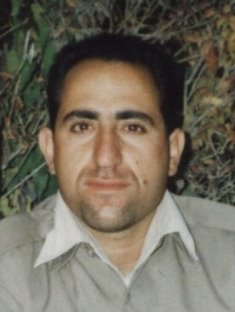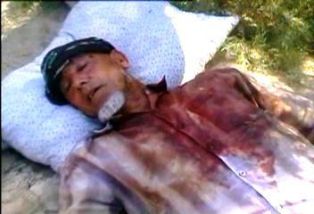
On July 8, a young student was arrested in Tehran for protesting against President Ahmadinejad’s disputed re-election. The security forces clubbed Amir Javadifar, 24, so badly that he was treated in hospital before being taken to the notorious Evin prison. His father was later called and told to collect his corpse.
The security forces ordered his family to say that he had died of a pre-existing condition but medical reports show that he had been beaten, sustaining several broken bones, and had his toenails pulled out. “My son was not involved in politics. He loved his motherland — that’s all,” said Javadifar’s recently widowed father. “I alone mourn him.”
Javadifar is just one among scores of alleged cases of murder, torture and rape unearthed by opposition investigators — cases that a regime claiming to champion Islamic values is doing its utmost to suppress by denouncing the charges as lies, arresting the investigators and seizing their files. The Times has been given access to 500 pages of documents — a small fraction of the total — that include handwritten testimony by victims, medical reports and interviews.
They suggest that security forces have engaged in systematic killing and torture to try to break the opposition.
“The use of rape and torture was similar across prisons in Tehran and the provinces. It is difficult not to conclude that the highest authorities planned and ordered these actions. Local authorities would not dare take such actions without word from above,” wrote one investigator, in a coded reference to Ayatollah Ali Khamenei, the Supreme Leader.
Mehdi Karoubi, 72, a defeated presidential candidate, said: “These crimes are a source of shame for the Islamic republic.”
Western non-governmental organisations said the documents corroborated what they were hearing from Iran, from where foreign journalists have been banned.
“We are repeatedly receiving credible reports of harsh beatings, sleep deprivation and alleged torture to extract false confessions in Iranian jails,” said Steve Crawshaw, UN director of Human Rights Watch. “Iran has fallen off the front pages but this doesn’t mean the situation is improving. On the contrary, we very much fear it is getting worse.”
The documents suggest that at least 200 demonstrators were killed in Tehran, with 56 others still unaccounted for, and that 173 were killed in other cities. These are several times higher than the official figures. Just over half of the 200 were killed on the streets. They were beaten around the head or shot in the head or chest as part of an apparent shoot-to-kill policy — there are no reports of demonstrators being shot in the legs.
Yacob Barvaye, 27, a student, was shot by Basiji militiamen from the top of the Lolagar mosque in Tehran on June 25, according to witnesses. Friends rushed him to hospital but he died of a brain haemorrhage. His family were standing over his body when the Basiji arrived and removed it. Two days later they called the family to say where they had buried it.
Ali Reza Tavasoli, 12, became separated from his father at a demonstration in the Behesht-e Zahra cemetery in Tehran commemorating the murder of Neda Soltan, the young woman whose videotaped death made her an opposition icon. His family stated that he had been killed in a car accident, but two doctors and a police officer have since testified that he died from blows to the head and that Basijis removed his body from the hospital.
His aunt says his impoverished parents were given the equivalent of $2,000 (£1,215) to lie about the boy’s death.
The rest of Tehran’s 200 known victims died in custody — detainees such as Amir Hossein Tufanian, 31, who was arrested on June 20 and taken to the Kahrizak detention centre. After his death, the police allegedly demanded that his family should pay thousands of dollars for his body, which bore marks of torture and had two broken arms. When the family protested that they had no money they were told they could have his corpse free if they made no fuss.
In three quarters of the cases, the victims’ families were told nothing about their whereabouts and were denied permission to hold proper funerals. The opposition claims that dozens were buried in unmarked graves in Behesht-e Zahra cemetery.
Mahmoud Rezayan, the cemetery chief, said coroners had certified that the bodies were those of unknown people who died in car accidents or from drug overdoses. The documents contain coroners’ statements denying that.
The documents also suggest that a chain of unofficial, makeshift prisons has been set up across Iran where rape and torture are common practice. In Tehran alone, 37 young men and women claim to have been raped by their jailers. Doctors’ reports say that two males, aged 17 and 22, died as a result of severe internal bleeding after being raped.
Many of the male rape victims also spoke of beatings, being subjected to forms of sexual humiliation including riding naked colleagues, and living in their underwear and in filthy conditions. Some testified that prisoners were subjected to torture including beatings, electrocution and having their toenails torn out.
“Where is the humanity among these agents?” one investigator scribbled on a document.
Female rape victims were mostly held for days, not weeks, like the men. Some said that their jailers claimed to have “religious sanction” to violate them as they were “morally dirty”.
Almost all, male and female, testified that they were ordered to say nothing of their ordeal or they would face more of the same.
The documents detail other systematic abuses: violent raids on student dormitories, attacks on the homes of suspected opposition sympathisers and the widespread intimidation of medics. They cite instances of security forces storming hospitals and ordering doctors not to treat injured demonstrators, not to record deaths by gunshot and to suppress medical reports indicating rape or torture.
Early last week, security forces raided offices of Mr Karoubi and Mir Hossein Mousavi, the other main
opposition candidate, and seized much of their evidence.
On Saturday a three-man panel set up by the head of the judiciary to investigate Mr Karoubi’s charges claimed that they were fabricated. Regime newspapers and supporters are demanding his arrest.
Undaunted, Mr Karoubi said on Monday that the attacks “show that I have hit on something extremely damaging to a number of political figures”.
He continued: “There are no few stories about the rape of girls and boys in prison. I say to myself three decades after the revolution and two decades after the death of the Imam [Ayatollah Khomeini] — what place have we reached?”



























































No comments:
Post a Comment